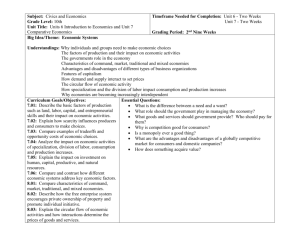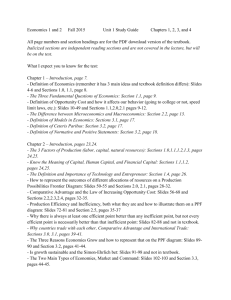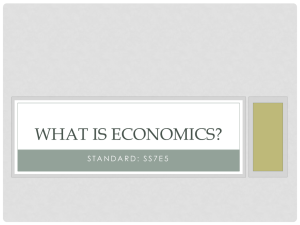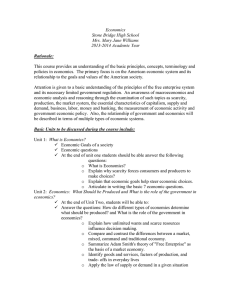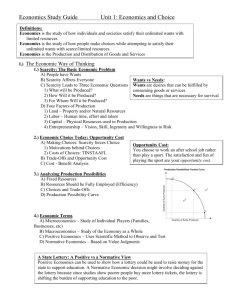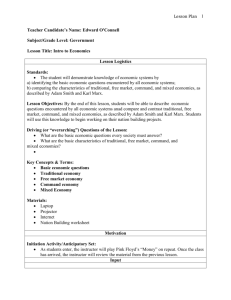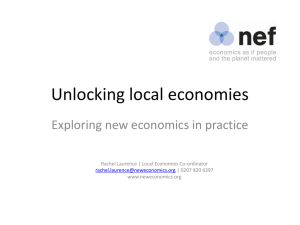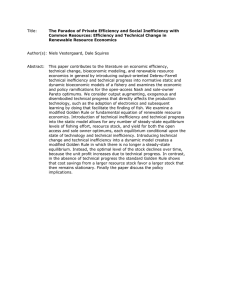Chapter 1
advertisement
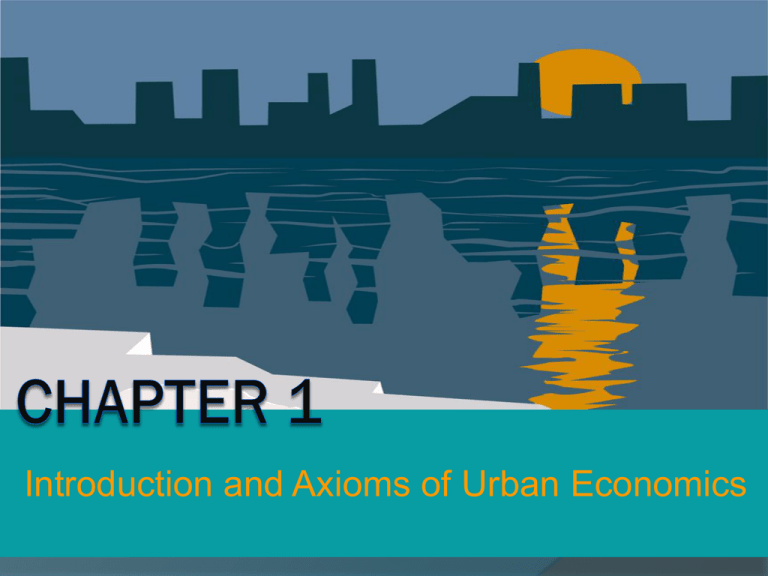
Introduction and Axioms of Urban Economics Urban Economics Urban economics combines both economics and geography: Economics explores how people make decisions under scarcity, while Geography explains where human activity occurs. Urban economics explores the location choices of maximizing agents. Areas of Urban Economics Market forces within the development of cities Land use Urban transportation Crime and Public Policy Housing and public policy Local government expenditure and taxes Urban Area Urban area is defined based on population density, the number of people living in a given area. An urban area has a high population density relative to surrounding areas. (Can agriculture be the prominent activity in cities?) Therefore, in an urban area there is frequent contact between different economic activities. For a city to develop Three conditions have to be satisfied for a city to develop The first condition: Agricultural surplus ○ The rural dwellers must produce enough food to provide for themselves as well as city dwellers. For a city to develop The second condition: Urban production ○ City dwellers must produce something to exchange with rural people for the food they grow. For a city to develop The third condition: Transportation for exchange ○ An efficient network of transportation has to exist to facilitate the exchange of food and urban products. The rise of an urban society We will see later that the transformation from a rural to an urban society was facilitated by technological advances that: increased agricultural surplus, Increased the productivity of urban workers, and Increased the efficiency of exchange and transportation. Five Axioms of Urban Economics 1. Prices adjust to achieve locational equilibrium Locational Equilibrium is achieved when given the prices of different locations every one is satisfied with his location, i.e. no incentive to move. Prices adjust so people are indifferent between desirable and undesirable locations. 2. Self Reinforcing Effects Generate Extreme Outcomes A change in something leading to additional changes in the same direction. Example: Concentration of automobile sellers in a certain area makes the area more attractive for other automobile sellers to locate, resulting in more concentration. 3. Externalities Cause Inefficiency When benefits or costs of a transaction fall on a third party, the market outcome is socially inefficient. Pollution and Market Inefficiency Price of Aluminum Marginal Social cost (MPC+ external cost) Tax= External Cost Supply (MPC) Optimum Equilibrium Demand (MPB) 0 QWELFARE QMARKET Quantity of Aluminum 4. Production is Subject to Economies of Scale Economies of scale occur when doubling all inputs of production results in more than doubling output. worker Number of machines 5 10 15 20 25 30 35 40 0 0 0 0 0 0 0 0 0 1 30 100 250 340 410 400 400 390 2 60 250 360 450 520 530 520 500 3 100 360 480 570 610 620 620 610 4 130 440 580 640 690 700 700 690 5 130 500 650 710 760 770 780 770 6 110 540 700 760 800 820 830 840 7 100 550 720 790 820 850 870 890 8 80 540 680 800 830 860 880 900 Economies of scale occur for two reasons: Indivisible inputs: when capital inputs are lumpy and cannot be scaled down for small operations. Economies of scale occur for two reasons: Factor specialization: dividing production into smaller tasks each undertaken by few workers. This is possible with a large scale of production. Scale Economies and cost When there are economies of scale in production, the average cost of production decreases as output increases. AC AC Q AC Q Q 5. Competition Generates Zero Economic Profit In the absence of barriers to entry, we expect firms to enter a market until economic profit is zero. This implies that the factors of production are earning their opportunity costs, i.e., just enough to keep them in business. In that case they are earning normal profit Example Adam decided to open a bakery. He could earn $50,000/ year in another job. He withdraws his savings from the bank, $100 000 , which was earning 7%. The market for baked goods is a perfect competitive market After paying all his expenses how much money do you expect Adam to be making in a year?
